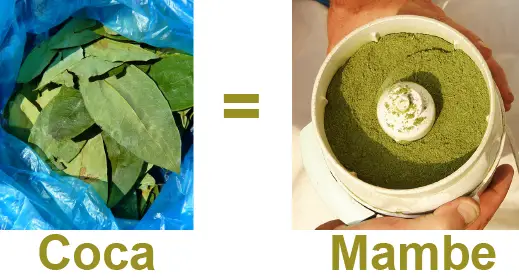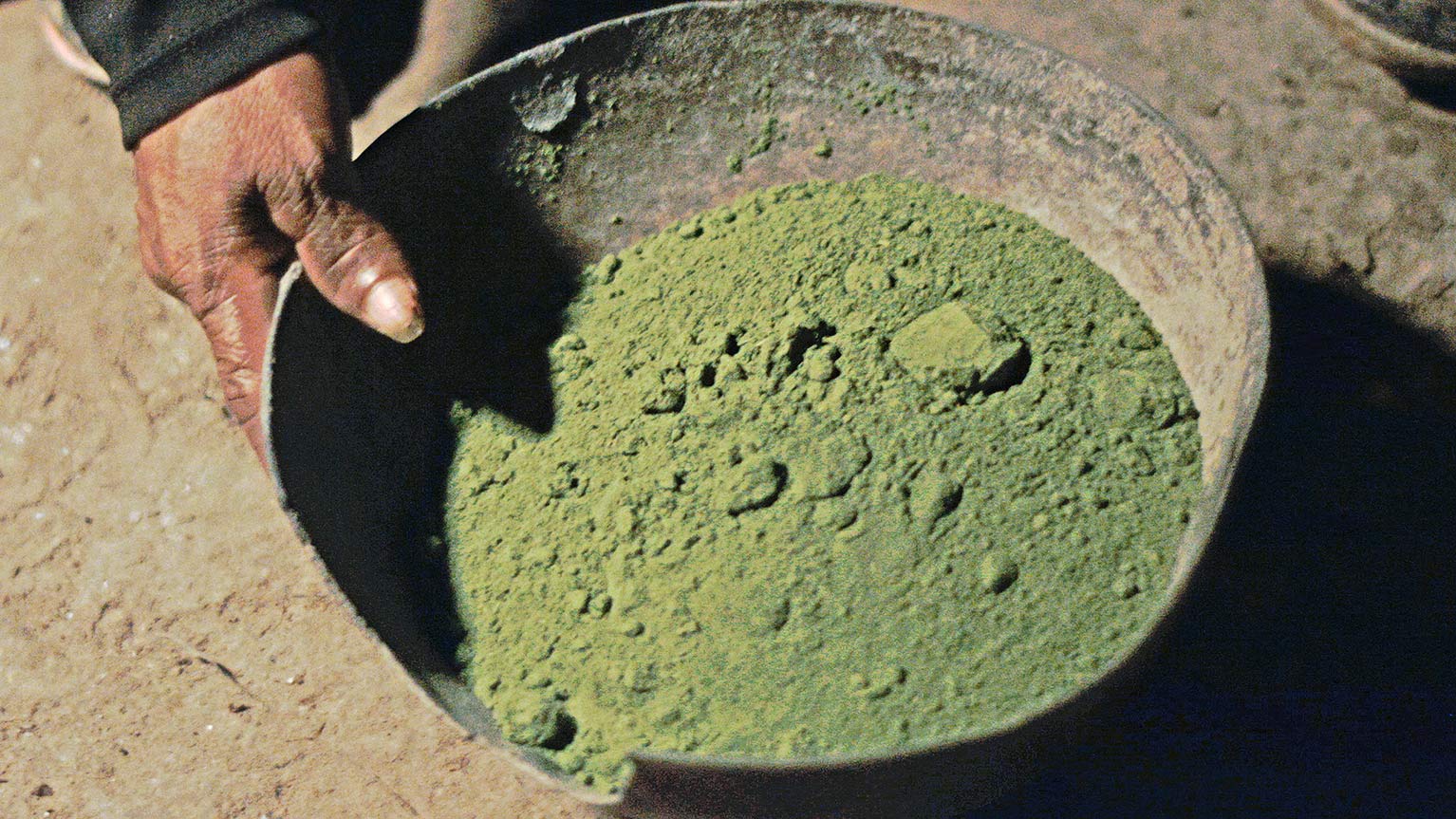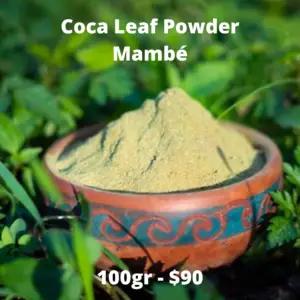
Looking to buy mambe medicine? Jump down to read more.
Table of Contents
What is mambe medicine?
Also known as ypadu, mambe is a fine powder made from toasted coca leaves and mixed with an alkaline reagent/substance, often yarumo (Cecropia peltata) ash, quinoa ash or burnt and crushed sea shell.
Mambé means “the tongue of God” or “word of life”. It has a feminine energy and represents the woman, as derived from the coca leaf, or mama coca.
This bitter powder is widely produced and used across South America:
- Venezuela
- Colombia
- Ecuador
- Peru
- Bolivia
- the North of Chile and Argentina
The ritual of mambe (which is the ancestral name of the coca leaf) is often a ritual of mambe and ambil, and this ritual gives you a unique experience in oral tradition.
Mambe gives power to word and gives those that take it eloquent. By chewing the mambe coca, we are able to connect to the intrinsic wisdom we each have inside so that we can share with the other participants.
This ritual is therapeutic and is based on sharing our life experiences through speech.
Mambe benefits and effects
The benefits of mambe are plenty. At a nutritional level, it is a supplement, containing the following proteins and vitamins:
- potassium
- calcium
- phosphorus
- iron
- sodium
- vitamin A, E, B1, B2, B3 and C
Additionally, mambe effects are that it:
- facilitates communication
- increases concentration
- augments your senses
- increases body temperature / heats body
- quells hunger
- energizes and wards off fatigue
- reduces altitude sickness
It is often taken to endure long work days, particularly when cultivating and harvesting.
In modern-day society, people may take it when driving long distances. In Colombia’s larger cities, mambe is increasingly consumed by students, researchers and professors that rely on it to concentrate over long hours.
And in the medicine world, mambe is often consumed before ceremonies when participants have been fasting and are starting to feel hunger and fatigue before a long night.
How do you use mambe powder in ceremony?
Mambe and ambil are often consumed together in ceremony.
Though there are varied traditions around the use of mambe powder in ceremony, one common way is in the context of a círculo de palabra, which literally translates to “word circle”, or when the community gathers in a circle to discuss matters relating to relationships, health, philosophy and decisions that the community must make.
This mambe ceremony often takes place in the late evening and continues on through the night to dawn.
During this ritual, ambil (tobaccos paste) may first be passed around. This causes the mouth to salivate, which makes it easier to absorb the mambe coca powder.
Next, the mambe powder is passed around and each individual carefully puts a small spoonful (sometimes more) into the cheek pocket, where it tends to clump. The idea is not to swallow it, but hold it in the cheek.
Following the mambe medicine, a pinch of dry coca leaves is added to the cheek pocket where the mambé is held. This mass is chewed together, thus forming a more solid ball/mass, which is held in the mouth until the next round of medicine.
This mambé and ambil ceremony may go through the night. The mambe powder and the ambil tobacco paste are both stimulants and keep individuals from falling asleep. In fact, after 2-3 rounds, participants tend to feel very alert.
Mambe medicine can also be taken more informally before and during other ceremonies, often energizing those that consume it for the long night ahead.

Mambe coca: What’s the difference between coca leaves and cocaine?
To this day, there exists a great cultural confusion about the difference between coca and cocaine. Mambe coca is often mistakenly thrown into the same category when actually this term only refers to mambe powder derived from coca leaves.
Coca is an age-old plant that has been used for its medicinal and spiritual properties for more than 8,000 years across South America. It is not a drug, however, though it can be transformed into cocaine much like caffeine might be isolated from a coffee bean.
Cocaine is a mix of chemicals like sulfuric acid, acetone, gasoline, diesel, sodium carbonate, potassium permanganate, cement (!!), among others. With this toxic mix, you can obtain the paste that creates cocaine, then cocaine hydrochloride. To make 1 kilogram of hydrochloride, you need 125 kilos of coca leaves. If you consider all of this, it’s much easier to understand, and accept, the difference between cocaine and coca.
Mambe drug?
“There is enough scientific evidence to substantiate the claim that the traditional use of coca has no negative health effects; that it serves positive therapeutic, sacred and social functions; and therefore that its classification as a narcotic drug was a mistake.” – TNI Drugs and Democracy
Despite the differences between cocaine and coca, you might still be wondering, “is mambe a drug?”
Answers will vary depending who you ask.
In literal terms, it would be classified as a drug. That is, it is a substance causing stimulant and physiological effects.
However, the word drug carries an extremely negative connotation (“Don’t do drugs.” ;), so we strongly avoid describing any of the sacred plant medicines as drugs.
Based on the effects of mambe and coca leaf in general, it falls into the same category as caffeine-based plant stimulants like tea, coffee, guayusa, & yerba mate.
“The use and consumption of the coca leaf do not cause psychological or physical changes greater than those resulting from the consumption of other plants and products which are in free and universal use.” – From formal reservations Bolivia made upon signing & ratifying the 1988 Convention.
Mambe is medicine and so much more. It carries its own spirit and, in its traditional use among indigenous peoples (and non-indigenous that wish to apply traditional wisdom), benefits the mind, body and community in ways modern-day society desperately needs.
How do you make mambe coca?
Mambe coca is fairly simple to make and you will find much variation in recipes across Colombia, Ecuador, Peru and Bolivia.
- Using a food processor, shred a bag (in batches) full of cleaned and dried coca leaves
- Grind the leaves until they become a fine powder.
- Using a sieve, separate remaining fibrous parts from the finer powder.
- Return the fine powder to the food processor
- In Peru, ash of quinoa straw is added to the mix (10% of ground coca leaves), in Colombia this can be instead yarumo. Grind some more in food processor.
- Store in an airtight container with a small spoon. Apply directly into mouth with spoon.
Where can you buy mambe coca?
It is getting more and more difficult to find providers in the US, we update these links (click on the photos) as frequently as possible.
In the US, you can buy mambé from the following providers (some ship from Europe):
Generally speaking, though, Mambe medicine, also called ypadú or in huitoto: jíibie, is not easily purchased outside of Mexico, Colombia, Ecuador, Peru and Bolivia because it is considered coca leaves and an ingredient in the production of cocaine.
That’s ridiculous, of course, and though we cannot ship this product abroad, if you are in Ecuador, please get in touch about buying this sacred mambe medicine.
Please note that though we might sell mambé, we will not sell other sacred medicines like ayahuasca, San Pedro / ahuacoya, Peyote or Yopo.
Is it illegal to bring coca leaves to the United States?
Yes, it is illegal to bring coca leaves to the US.
Coca leaves, in any of its forms, including as mambe, tea or whole leaves, are considered a Schedule II substance and therefore illegal.
Mambe Leaves
The term mambe leaves is nonsensical. Mambe is a powder made from crushed coca leaves, so it is impossible for mambe leaves to exist. When this terms is (incorrectly) used, the person using it is almost certainly referring to coca leaves.

More on Mambe Coca and Mambe Powder
- Coca Yes, Cocaine No?: Legal options for the coca leaf – 2006
- Nutritional Value of Coca – 1975
- COCA AND COCAINE: Effects on People and Policy in Latin America – 1985
Medicina Mambe Coca
Si desea obtener este producto, por favor mande un correo a [email protected]
El ritual del mambe, nombre ancestral de la planta de coca, es una experiencia única de tradición oral. El mambe le da poder a la palabra y nos brinda elocuencia. Masticando sus hojas podemos conectarnos con la sabiduría intrínseca que hay en nuestro interior, para compartirla con los demás participantes. Es un ritual donde la terapia se basa en el compartir la palabra y nuestras experiencias de vida.
Existe una grande confusión cultural acerca de la diferencia entre coca y la cocaína. La coca es una planta milenaria que se ha utilizado por sus propiedades medicinales y espirituales desde hace más de 8000 años en Suramérica, no es droga, sin embargo, puede ser transformada en cocaína. La cocaína es una mezcla de químicos como ácido sulfúrico, acetona, gasolina, diésel, carbonato de sodio, permanganato de potasio y cemento entre otros. Con esta toxica mezcla se obtiene la pasta básica de cocaína y luego de clorhidrato. Para un kilo de clorhidrato se necesitan 125 kilos de hojas de coca. La diferencia es sencilla es para nosotros bastante obvia y sencilla.


